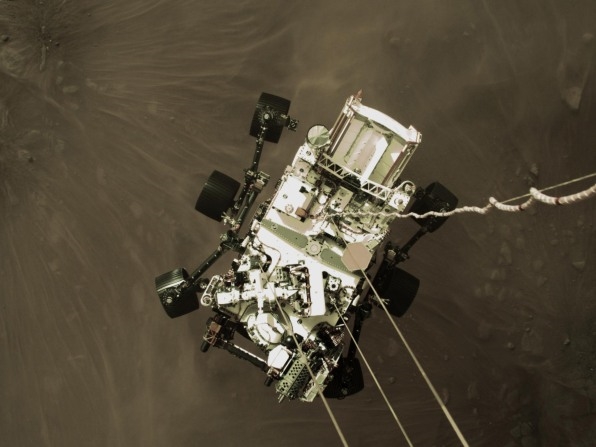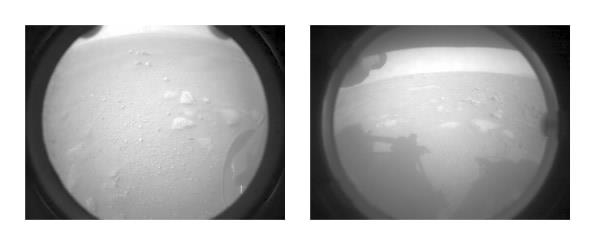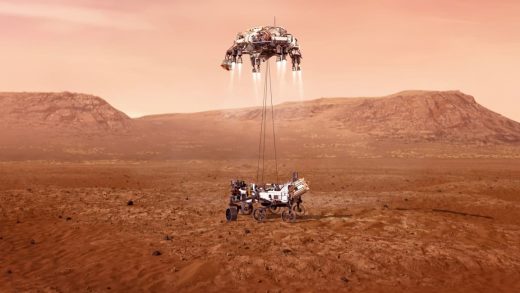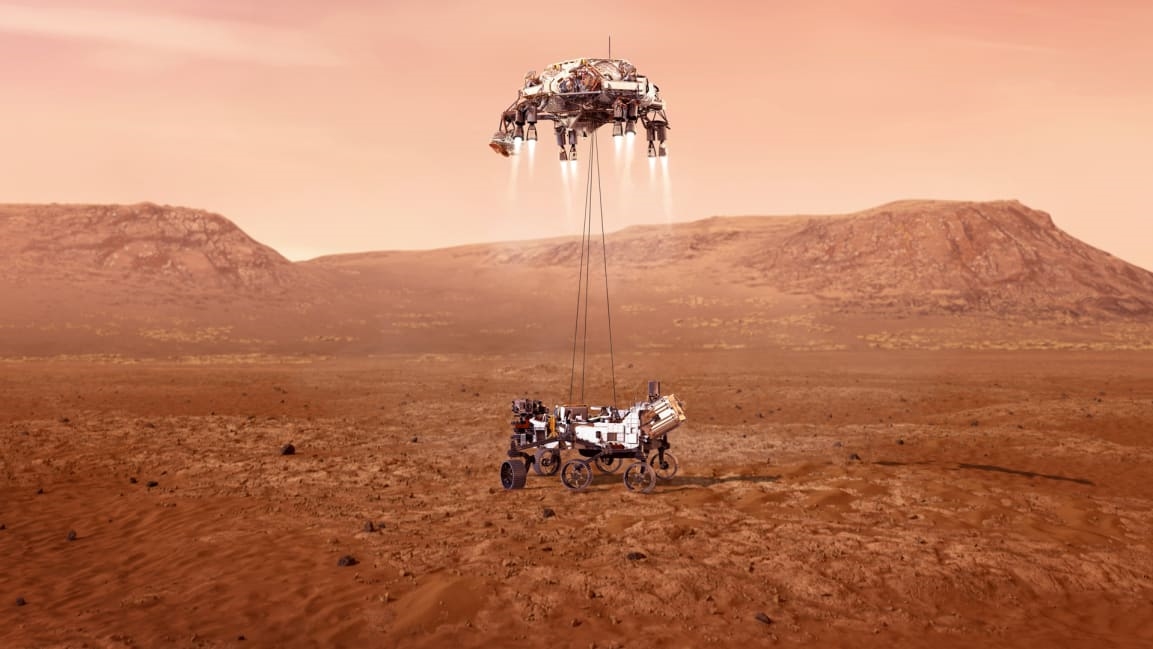Watch the Perseverance rover land on Mars in this just-released video
February 22, 2021
Since we began sending probes to the surface of Mars, our experience of their landings was a nail-biting silence, punctured only by a NASA Mission Control engineer announcing milestones in the spacecraft progress.
That all changed with the Mars 2020 Perseverance rover filming its February 18 landing. Six of the 23 onboard commercial cameras shot high-definition footage of the supersonic descent—dubbed the “7 minutes of terror“—and first surface movements. Three cameras trained on the parachute, while another three videoed the descent stage, rover, and approaching ground. Jet Propulsion Laboratory (JPL), the Pasadena, California, facility that built the rover and manages the $2.7 billion mission, premiered its high-resolution video during today’s briefing. This marks the first time we’re able to watch a spacecraft land on another planet. “These images and videos are the stuff of our dreams,” said Mars 2020 entry, descent, and landing (EDL) lead engineer Allen Chen.
“I just couldn’t believe my eyes; the images were better than I could have imagined,” JPL’s Adam Nelessen told Fast Company about his initial reaction to the footage. An EDL lead systems engineer, Nelessen focused on the EDL camera technology. “There is a lot that we can learn from the imagery. One of the best engineering outcomes is going to be recording the inflation of the parachute at a high frame rate. We’re going to learn just how well this thin piece of fabric is actually performing.”
This is also the first time EDL engineers have seen the landing process unfurl in its entirety, as they were only able to run tests in separate stages on Earth. The footage revealed that the EDL navigation system came to within 16 feet of its landing target. The video also gave a better sense of the debris that kicks up during landing, particularly as NASA looks to land increasingly heavier items on Mars.
“We worry about dust and sand confounding radar sensors and making our landing more difficult,” he adds. “So seeing what the dust environment and hazards are like in the area have really good engineering uses for us.” Plus, observing the landing site on approach offers a head start on how to best navigate the area to achieve the science objectives. More raw images of Mars can be found here.

[Photo: NASA/JPL-Caltech]
Additionally, the rover has two onboard microphones for the first time. Sadly, a communications error between the device digitizing the analog sound and the computer storing the data prevented them from recording EDL sound. But they did pick up 11 mph gusts of wind on the surface, which also played during today’s briefing, and which you can listen to here.
Looking for signs of life
Perseverance hit the Martian atmosphere at 12,000 mph, weathering nearly 2,400 degrees Fahrenheit, and slowing to 160 mph before deploying a 70-foot-diameter parachute. Onboard navigation systems timed the parachute release with the spacecraft’s position to the landing site to steer it clear of hazardous terrain. Retro-rockets firing groundwards helped the craft decelerate to 1.5 mph by the time the sky-crane maneuver gently lowered the rover to a safe spot on Jezero Crater, an ancient lake bed that may have once harbored life. (You can replay the landing commentary here.) The landing was so difficult, demanding some two million lines of flight code, that NASA Science Mission Directorate associate administrator Thomas Zurbuchen celebrated its success by gleefully ripping up the mission contingency plans during the post-landing briefing.
“Perseverance is the most advanced mission humans have ever sent to the red planet’s surface,” said NASA Planetary Science Division director Lori Glaze. (Glaze and the remaining NASA officials in this story spoke during virtual January 27 and February 17 press conferences.) “One of its main purposes is to seek out signs of past life on Mars.” Other aspects, such as monitoring environmental conditions, will be “paramount to increasing our understanding of how to protect future human explorers.”

[Photos: NASA/JPL-Caltech]
For the next two years, a 450-member global science team will guide Perseverance on a 10- to 15-mile journey exploring the area’s four-billion-year-old geology and drilling for samples suggesting past microscopic life. As the first step in the Mars Sample Return campaign, a NASA-European Space Agency partnership, the rover will set aside the most promising samples in caches, beginning this summer, for subsequent retrieval and return to Earth. In 2026 or 2028, NASA will send another craft to retrieve the samples and return them to Earth in 2031 for more detailed study.
Unlike previous rovers, Mars 2020 cameras will shoot color to enable imaging spectroscopy to determine the chemical compositions of samples. The microphones will enable scientists to use acoustic vibrations to determine geological properties and gauge the health of the vehicle. “It’s a new human sense along for the ride,” said Perseverance project scientist Ken Farley.
This mission will also demonstrate two experimental technologies to serve future explorations. MOXIE will produce oxygen from carbon dioxide in the Martian atmosphere for life support and fuel. The miniature Ingenuity Mars Helicopter will attempt five 90-second test flights in the spring as the first aircraft to fly on another planet. Future generations of this prototype might enable aerial explorations and carry small payloads. Readers wanting a deeper experience with recreating the Perseverance landing and searching for ancient life can download the Mission to Mars AR app. And on February 24, PBS’s Nova will premiere a behind-the-scenes look at the mission, Looking for Life on Mars.
Heading to Mars during a pandemic
Perseverance proved an apt name for the Mars rover in the age of COVID-19. The mission’s most difficult aspect had been keeping the craft microbe-free during its building—until the pandemic forced the launch date back twice and threatened to delay it for two years, until Mars would be back in the best position relative to Earth to require the least amount of fuel to get there. (As if that wasn’t enough, an earthquake also rattled JPL Mission Control 20 minutes before the rover’s July launch.)
After working on five Martian probes, “I thought I’d seen just about everything, until a year ago, when I was proven wrong and had to face a global pandemic,” said JPL deputy project manager Matt Wallace. “We were in the final processing at Kennedy, and our teams were trying to figure out how to keep safe and make progress. It was the first time during development where we felt the launch might be in some jeopardy.”
NASA marked this challenge with a small plaque attached to the chassis honoring the healthcare community. The rover also carried three microfiches of 11 million names of people who signed up to have it take their names to Mars. You can sign up here for the next mission to Mars.
With the samples slated for a return in the 2030s and analysis in subsequent decades, “This is a serious investment in the future of our science,” said Farley. “The scientists who will analyze these samples are in school today, or may not even be born yet.”
Fast Company , Read Full Story
(44)



